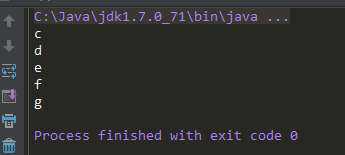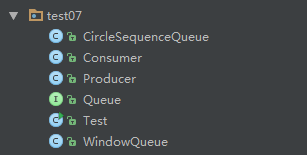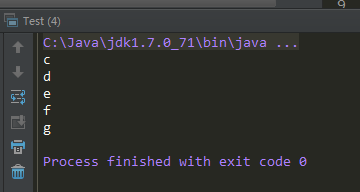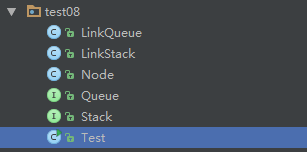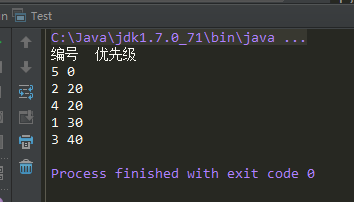数据结构Java实现07----队列:顺序队列&顺序循环队列、链式队列、顺序优先队列
一、队列的概念:
队列(简称作队,Queue)也是一种特殊的线性表,队列的数据元素以及数据元素间的逻辑关系和线性表完全相同,其差别是线性表允许在任意位置插入和删除,而队列只允许在其一端进行插入操作在其另一端进行删除操作。
队列中允许进行插入操作的一端称为队尾,允许进行删除操作的一端称为队头。队列的插入操作通常称作入队列,队列的删除操作通常称作出队列。
下图是一个依次向队列中插入数据元素a0,a1,...,an-1后的示意图:
上图中,a0是当前 队头数据元素,an-1是当前 队尾数据元素。
为了避免当只有一个元素时,对头和队尾重合使得处理变得麻烦,所以引入两个指针:front指针指向队头元素,rear指针指向队尾元素的下一个位置,这样的话,当front指针等于rear时,此队列不是还剩一个元素,而是空队列。
二、队列的抽象数据类型:
数据集合:
队列的数据集合可以表示为a0,a1,…,an-1,每个数据元素的数据类型可以是任意的类型。
操作集合:
(1)入队列append(obj):把数据元素obj插入队尾。
(2)出队列delete():把队头数据元素删除并由函数返回。
(3)取队头数据元素getFront():取队头数据元素并由函数返回。
(4)非空否isEmpty():非空否。若队列非空,则函数返回false,否则函数返回true。
三、循环顺序队列:
线性表有顺序存储和链式存储,队列是一种特殊的线性表,同样也存在这两种存储方式。我们先来看一下队列的顺序存储。
1、顺序队列的“假溢出”:
上图中,front指针指向队头元素,rear指针指向队尾元素的下一个位置。图(d)中b、c、d出队后,front指针指向元素e,rear指 针在数组外面。假设这个队列的总个数不超过5个,但目前如果接着入队的话,因数组末尾元素已经被占用,再向后加就会产生数组越界的错误,可实际上队列在下 标为0、1、2、3、4的地方还是空闲的,我们把这种现象叫做“假溢出”。
2、循环顺序队列:
所以解决假溢出的办法就是后面满了,就再从头开始,也就是头尾相接的循环。我们把队列的这种逻辑上首尾相连的顺序存储结构称为循环队列。
如何判断循环队列究竟是空的还是满的:
现在问题又来了,我们之前说,空队列时,front指针等于rear指针,那么现在循环队列满的时候,也是front等于rear,那么如何判断循环队列究竟是空的还是满的?有如下办法:
- 办法1:设置一个标志位flag。初始时置flag=0;每当入队列操作成功就置flag=1;每当出队列操作成功就置flag=0。则队列空的 判断条件为:rear == front && tag==0;队列满的判断条件为:rear = = front && tag= =1。
- 办法2:保留一个元素的存储空间。此时,队列满时的判断条件为 (rear + 1) % maxSize == front;队列空的判断条件还是front == rear。
- 办法3:设计一个计数器count,统计队列中的元素个数。此时,队列满的判断条件为:count > 0 && rear == front ;队列空的判断条件为count == 0。
我们在接下来的代码中采用方法3来实现。
3、代码实现:(循环顺序队列的创建)
(1)Queue.java:(队列接口)
1 //队列接口
2 public interface Queue {
3
4 //入队
5 public void append(Object obj) throws Exception;
6
7 //出队
8 public Object delete() throws Exception;
9
10 //获得队头元素
11 public Object getFront() throws Exception;
12
13 //判断对列是否为空
14 public boolean isEmpty();
15 }
(2)CircleSequenceQueue.java:(循环顺序队列)
1 //循环顺序队列
2 public class CircleSequenceQueue implements Queue {
3
4 static final int defaultSize = 10; //默认队列的长度
5 int front; //队头
6 int rear; //队尾
7 int count; //统计元素个数的计数器
8 int maxSize; //队的最大长度
9 Object[] queue; //队列
10
11 public CircleSequenceQueue() {
12 init(defaultSize);
13 }
14
15 public CircleSequenceQueue(int size) {
16 init(size);
17 }
18
19 public void init(int size) {
20 maxSize = size;
21 front = rear = 0;
22 count = 0;
23 queue = new Object[size];
24 }
25
26 @Override
27 public void append(Object obj) throws Exception {
28 // TODO Auto-generated method stub
29 if (count > 0 && front == rear) {
30 throw new Exception("队列已满!");
31 }
32 queue[rear] = obj;
33 rear = (rear + 1) % maxSize;
34 count++;
35 }
36
37 @Override
38 public Object delete() throws Exception {
39 // TODO Auto-generated method stub
40 if (isEmpty()) {
41 throw new Exception("队列为空!");
42 }
43 Object obj = queue[front];
44 front = (front + 1) % maxSize;
45 count--;
46 return obj;
47 }
48
49 @Override
50 public Object getFront() throws Exception {
51 // TODO Auto-generated method stub
52 if (!isEmpty()) {
53 return queue[front];
54 } else {
55 return null;
56 }
57 }
58
59 @Override
60 public boolean isEmpty() {
61 // TODO Auto-generated method stub
62 return count == 0;
63 }
64
65 }
(3)Test.java:
1 public class Test {
2 public static void main(String[] args) throws Exception {
3
4 CircleSequenceQueue queue = new CircleSequenceQueue();
5 queue.append("a");
6 queue.append("b");
7 queue.append("c");
8 queue.append("d");
9 queue.append("e");
10 queue.append("f");
11
12 queue.delete();
13 queue.delete();
14
15 queue.append("g");
16
17 while (!queue.isEmpty()) {
18 System.out.println(queue.delete());
19 }
20 }
21 }
运行效果:
4、循环队列应用:
使用顺序循环队列和多线程实现一个排队买票的例子。而且,我们只允许这个队伍中同时排队的只有10个人,那就需要用到队列了。
生产者(等候买票)
消费者 (买票离开)
这里面我们需要用到上面的Queue.java类和CircleSequenceQueue.java类。
代码结构:
(3)WindowQueue.java:
1 //卖票窗口
2 public class WindowQueue {
3
4 //卖票的队列
5 int maxSize = 10;
6 CircleSequenceQueue queue = new CircleSequenceQueue(maxSize);
7 int num = 0; //统计卖票的数量,一天最多卖100张票。
8 boolean isAlive = true; //判断是否继续卖票。
9
10 //排队买票
11 public synchronized void producer() throws Exception {
12 if (queue.count < maxSize) {
13 queue.append(num++); //等待买票的数量加1
14 System.out.println("第" + num + "个客户排队等待买票!");
15 this.notifyAll();//唤醒卖票的线程
16 } else {
17 try {
18 System.out.println("队列已满...请等待!");
19 this.wait();//队列满时,排队买票线程等待。
20 } catch (Exception ex) {
21 ex.printStackTrace();
22 }
23 }
24 }
25
26 //卖票
27 public synchronized void consumer() throws Exception {
28 if (queue.count > 0) {
29 Object obj = queue.delete();
30 int temp = Integer.parseInt(obj.toString());
31 System.out.println("第" + (temp + 1) + "个客户买到票离开队列!");
32 //如果当前队列为空,并且卖出票的数量大于等于100,说明卖票结束
33 if (queue.isEmpty() && this.num >= 100) {
34 this.isAlive = false;
35 }
36 this.notifyAll(); //唤醒排队买票的线程。
37 } else {
38 try {
39 System.out.println("队列已空...请等待!");
40 this.wait();//队列空时,卖票线程等待。
41 } catch (Exception ex) {
42 ex.printStackTrace();
43 }
44 }
45 }
46 }
(4)Producer.java:
1 //买票者
2 public class Producer implements Runnable {
3
4 WindowQueue queue;
5
6 public Producer(WindowQueue queue) {
7 this.queue = queue;
8 }
9
10 @Override
11 public void run() {
12 // TODO Auto-generated method stub
13 while (queue.num < 100) {
14 try {
15 queue.producer();
16 } catch (Exception ex) {
17 ex.printStackTrace();
18 }
19 }
20 }
21
22 }
(5)Consumer.java:
//卖票者
public class Consumer implements Runnable {
WindowQueue queue;
public Consumer(WindowQueue queue) {
this.queue = queue;
}
@Override
public void run() {
// TODO Auto-generated method stub
while (queue.isAlive) {
try {
queue.consumer();
} catch (Exception ex) {
ex.printStackTrace();
}
}
}
}
(6)test.java:
1 public class Test {
2
3 public static void main(String[] args) throws Exception {
4
5 WindowQueue queue = new WindowQueue();
6
7 Producer p = new Producer(queue);//注意一定要传同一个窗口对象
8 Consumer c = new Consumer(queue);
9
10 //排队买票线程
11 Thread pThread = new Thread(p);
12 //卖票线程
13 Thread cThread = new Thread(c);
14
15 pThread.start(); //开始排队买票
16 cThread.start(); //开始卖票
17 }
18
19 }
注意第07行的注释。
运行效果:
四、链式队列:
链式队列其实就是特殊的单链表,只不过它只能尾进头出而已。链式队列的存储结构如下图所示:
1、链式队列的实现:
(1)Node.java:结点类
1 //结点类
2 public class Node {
3
4 Object element; //数据域
5 Node next; //指针域
6
7 //头结点的构造方法
8 public Node(Node nextval) {
9 this.next = nextval;
10 }
11
12 //非头结点的构造方法
13 public Node(Object obj, Node nextval) {
14 this.element = obj;
15 this.next = nextval;
16 }
17
18 //获得当前结点的后继结点
19 public Node getNext() {
20 return this.next;
21 }
22
23 //获得当前的数据域的值
24 public Object getElement() {
25 return this.element;
26 }
27
28 //设置当前结点的指针域
29 public void setNext(Node nextval) {
30 this.next = nextval;
31 }
32
33 //设置当前结点的数据域
34 public void setElement(Object obj) {
35 this.element = obj;
36 }
37
38 public String toString() {
39 return this.element.toString();
40 }
41 }
(2)Queue.java:
1 //队列接口
2 public interface Queue {
3
4 //入队
5 public void append(Object obj) throws Exception;
6
7 //出队
8 public Object delete() throws Exception;
9
10 //获得队头元素
11 public Object getFront() throws Exception;
12
13 //判断对列是否为空
14 public boolean isEmpty();
15 }
(3)LinkQueue.java:
1 public class LinkQueue implements Queue {
2
3 Node front; //队头
4 Node rear; //队尾
5 int count; //计数器
6
7 public LinkQueue() {
8 init();
9 }
10
11 public void init() {
12 front = rear = null;
13 count = 0;
14 }
15
16 @Override
17 public void append(Object obj) throws Exception {
18 // TODO Auto-generated method stub
19 Node node = new Node(obj, null);
20
21 //如果当前队列不为空。
22 if (rear != null) {
23 rear.next = node; //队尾结点指向新结点
24 }
25
26 rear = node; //设置队尾结点为新结点
27
28 //说明要插入的结点是队列的第一个结点
29 if (front == null) {
30 front = node;
31 }
32 count++;
33 }
34
35 @Override
36 public Object delete() throws Exception {
37 // TODO Auto-generated method stub
38 if (isEmpty()) {
39 new Exception("队列已空!");
40 }
41 Node node = front;
42 front = front.next;
43 count--;
44 return node.getElement();
45 }
46
47 @Override
48 public Object getFront() throws Exception {
49 // TODO Auto-generated method stub
50 if (!isEmpty()) {
51 return front.getElement();
52 } else {
53 return null;
54 }
55 }
56
57 @Override
58 public boolean isEmpty() {
59 // TODO Auto-generated method stub
60 return count == 0;
61 }
62
63 }
(4)Test.java:
1 public class Test {
2
3 public static void main(String[] args) throws Exception {
4
5 LinkQueue queue = new LinkQueue();
6 queue.append("a");
7 queue.append("b");
8 queue.append("c");
9 queue.append("d");
10 queue.append("e");
11 queue.append("f");
12
13 queue.delete();
14 queue.delete();
15
16 queue.append("g");
17
18 while (!queue.isEmpty()) {
19 System.out.println(queue.delete());
20 }
21 }
22 }
运行效果:
2、链式队列的应用:
题目:
编写一个判断一个字符串是否是回文的算法。
思路:
设字符数组str中存放了要判断的字符串。把字符数组中的字符逐个分别存入一个队列和栈中,然后逐个出队和出栈比较出队的字符与出栈的字符是否相同,若全部相等则该字符串为回文。
代码实现:
这里面需要用到上面一段中的LinkQueue类。代码结构如下:
(4)Stack.java:栈接口
1 //栈接口
2 public interface Stack {
3
4 //入栈
5 public void push(Object obj) throws Exception;
6
7 //出栈
8 public Object pop() throws Exception;
9
10 //获得栈顶元素
11 public Object getTop() throws Exception;
12
13 //判断栈是否为空
14 public boolean isEmpty();
15 }
(5)LinkStack.java:
1 public class LinkStack implements Stack {
2
3 Node head; //栈顶指针
4 int size; //结点的个数
5
6 public LinkStack() {
7 head = null;
8 size = 0;
9 }
10
11 @Override
12 public Object getTop() throws Exception {
13 // TODO Auto-generated method stub
14 return head.getElement();
15 }
16
17 @Override
18 public boolean isEmpty() {
19 // TODO Auto-generated method stub
20 return head == null;
21 }
22
23 @Override
24 public Object pop() throws Exception {
25 // TODO Auto-generated method stub
26 if (isEmpty()) {
27 throw new Exception("栈为空!");
28 }
29 Object obj = head.getElement();
30 head = head.getNext();
31 size--;
32 return obj;
33
34 }
35
36 @Override
37 public void push(Object obj) throws Exception {
38 // TODO Auto-generated method stub
39 head = new Node(obj, head);
40 size++;
41 }
42
43 }
(6)Test.java:测试类
1 public class Test {
2
3 public static void main(String[] args) throws Exception {
4
5 String str1 = "ABCDCBA"; //是回文
6 String str2 = "ABCDECAB"; //不是回文
7
8 try {
9 if (Test.isHuiWen(str1)) {
10 System.out.println(str2 + ":是回文!");
11 } else {
12 System.out.println(str2 + ":不是回文!");
13 }
14 } catch (Exception ex) {
15 ex.printStackTrace();
16 }
17 }
18
19
20 //方法:判断字符串是否回文
21 public static boolean isHuiWen(String str) throws Exception {
22 int n = str.length();
23 LinkStack stack = new LinkStack();//创建堆栈
24 LinkQueue queue = new LinkQueue();//创建队列
25 for (int i = 0; i < n; i++) {
26 stack.push(str.subSequence(i, i + 1)); //把字符串每个字符压进堆栈
27 queue.append(str.subSequence(i, i + 1));//把字符串每个字符压入队列
28 }
29 while (!queue.isEmpty() && !stack.isEmpty()) {
30 if (!queue.delete().equals(stack.pop())) { //出队列,出栈,同时判断是否相同
31 return false;
32 }
33 }
34
35 return true;
36 }
37
38 }
3、循环队列和链式队列的比较:
(1)从时间上看,它们的基本操作都是常数时间,即O(1)的。不过循环队列是事先申请好空间,使用期间不释放;而链式队列,每次申请和释放结点也会存在一定的时间开销,如果入栈和出栈比较频繁,则两者还是有细微的差别。
(2)从空间上看,循环队列必须有一个固定的长度,所以就有了存储元素个数和空间浪费的问题。而链式队列不存在这个问题,尽管它需要一个指针域,会产生一些空间上的开销,但也可以接受。所以在空间上,链式队列更加灵活。
总结:总的来说,在可以确定队列长度的最大值的情况下,建议用循环队列,如果你无法估计队列的长度,那就用链式队列。
五、优先级队列:
优先级队列是带有优先级的队列。
用顺序存储结构实现的优先级队列称作顺序优先级队列。
用链式存储结构存储的优先级队列称作链式优先级队列。
顺序优先级队列和顺序循环队列相比主要有两点不同:
(1)对于顺序优先级队列来说,出队列操作不是把队头数据元素出队列,而是把队列中优先级最高的数据元素出队列。(入队操作没区别)
(2)对于顺序优先级队列来说,数据元素由两部分组成,一部分是原先意义上的数据元素,另一部分是优先级。通常设计优先级为int类型的数值,并规定数值越小优先级越高。
1、顺序优先队列的实现:
设计顺序优先级队列分为两个类:
数据元素类
优先级队列类
代码实现:
(1)Element.java:
1 //优先级队列元素类
2 public class Element {
3
4 private Object element; // 数据
5 private int priority; // 优先级
6
7 public Element(Object obj, int priority) {
8 this.element = obj;
9 this.priority = priority;
10 }
11
12 public Object getElement() {
13 return element;
14 }
15
16 public void setElement(Object element) {
17 this.element = element;
18 }
19
20 public int getPriority() {
21 return priority;
22 }
23
24 public void setPriority(int priority) {
25 this.priority = priority;
26 }
27
28 }
(2)Queue.java:
1 //队列接口
2 public interface Queue {
3
4 //入队
5 public void append(Object obj) throws Exception;
6
7 //出队
8 public Object delete() throws Exception;
9
10 //获得队头元素
11 public Object getFront() throws Exception;
12
13 //判断对列是否为空
14 public boolean isEmpty();
15 }
(3)PrioritySequenceQueue.java:
1 //优先级队列
2 public class PrioritySequenceQueue implements Queue {
3
4 static final int defaultSize = 10; //默认队列长度
5 int front; //队头
6 int rear; //队尾
7 int count; //计数器
8 int maxSize; //队列最大长度
9 Element[] queue; //队列
10
11 public PrioritySequenceQueue() {
12 init(defaultSize);
13 }
14
15 public PrioritySequenceQueue(int size) {
16 init(size);
17 }
18
19 public void init(int size) {
20 maxSize = size;
21 front = rear = 0;
22 count = 0;
23 queue = new Element[size];
24 }
25
26 @Override
27 public void append(Object obj) throws Exception {
28 // TODO Auto-generated method stub
29 //如果队列已满
30 if (count >= maxSize) {
31 throw new Exception("队列已满!");
32 }
33 queue[rear] = (Element) obj;
34 rear++;
35 count++;
36 }
37
38 @Override
39 public Object delete() throws Exception {
40 // TODO Auto-generated method stub
41 if (isEmpty()) {
42 throw new Exception("队列为空!");
43 }
44 //默认第一个元素为优先级最高的。
45 Element min = queue[0];
46 int minIndex = 0;
47 for (int i = 0; i < count; i++) {
48 if (queue[i].getPriority() < min.getPriority()) {
49 min = queue[i];
50 minIndex = i;
51 }
52 }
53
54 //找的优先级别最高的元素后,把该元素后面的元素向前移动。
55 for (int i = minIndex + 1; i < count; i++) {
56 queue[i - 1] = queue[i]; //移动元素
57 }
58 rear--;
59 count--;
60 return min;
61 }
62
63 @Override
64 public Object getFront() throws Exception {
65 // TODO Auto-generated method stub
66 if (isEmpty()) {
67 throw new Exception("队列为空!");
68 }
69 //默认第一个元素为优先级最高的。
70 Element min = queue[0];
71 int minIndex = 0;
72 for (int i = 0; i < count; i++) {
73 if (queue[i].getPriority() < min.getPriority()) {
74 min = queue[i];
75 minIndex = i;
76 }
77 }
78 return min;
79 }
80
81 @Override
82 public boolean isEmpty() {
83 // TODO Auto-generated method stub
84 return count == 0;
85 }
86
87 }
2、代码测试:
设计一个程序模仿操作系统的进程管理问题。进程服务按优先级高的先服务,优先级相同的先到先服务的原则管理。
模仿数据包含两个部分:进程编号和优先级。如下有五个进程:
1 30
2 20
3 40
4 20
5 0 ----------优先级最高,先服务
(4)Test.java:
1 public class Test {
2
3 public static void main(String[] args) throws Exception {
4
5 PrioritySequenceQueue queue = new PrioritySequenceQueue();
6 Element temp;
7
8 //五个进程入队
9 queue.append(new Element(1, 30));
10 queue.append(new Element(2, 20));
11 queue.append(new Element(3, 40));
12 queue.append(new Element(4, 20));
13 queue.append(new Element(5, 0));
14
15 //按照优先级出队。
16 System.out.println("编号 优先级");
17 while (!queue.isEmpty()) {
18 temp = (Element) queue.delete();
19 System.out.println(temp.getElement() + " " + temp.getPriority());
20 }
21 }
22 }
运行效果:



